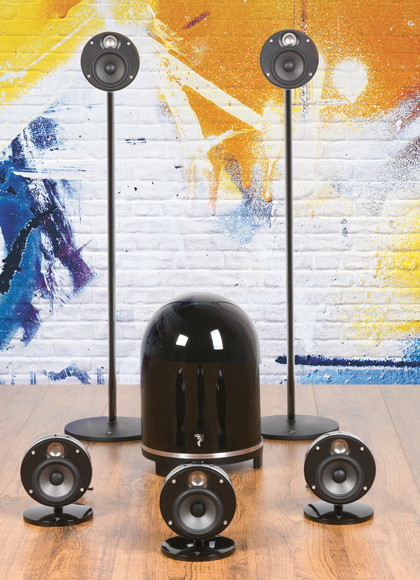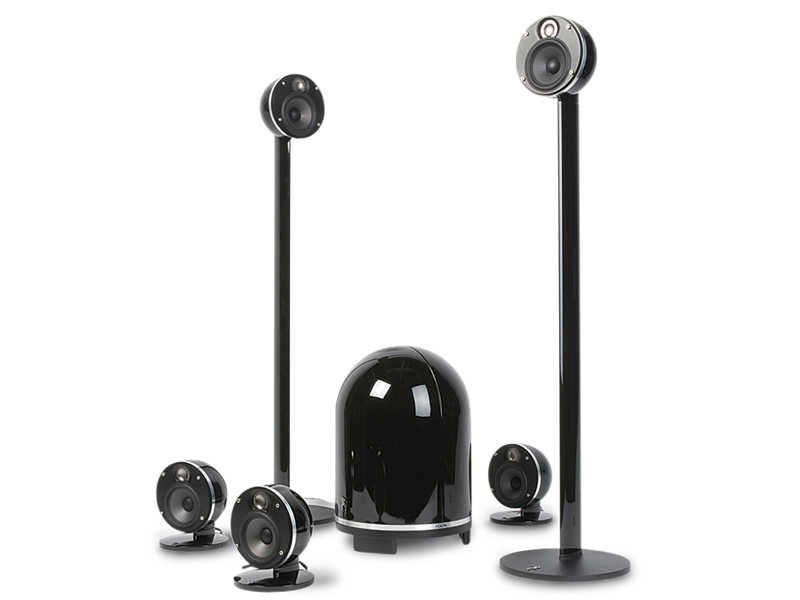TechRadar Verdict
If you're in the market for a Sub/Sat system and don't want to compromise on style as well as substance, we recommend giving these an audition
Pros
- +
Bold, Full and detailed sound quality for music and home cinema
- +
Gorgeous design
Cons
- -
Larger cabinets will offer more presence
- -
Rival sub/systems are more affordable
Why you can trust TechRadar
Focal JMlab is one of Europe's leading hi-fi manufacturers and is best known in the field of larger loudspeakers, its expertise with the Sib & Cub fashion-centric, compact system shows it can also dabble with the latter. And that skill has now been used to craft a hugely stylish successor, dubbed Dome.
There are a number of quality compact systems from recognised hi-fi marques designed to plug the gap between these two broad categories, from names that include, KEF, Cabasse, Bose, and B&W.
Focal is not alone in attempting to marry attractive designer packaging with hi-fi audio standards. But on the basis of the Dome, it is undeniably one of the most successful.
Just small enough
Though a compact system, the dome-shaped satellites are not as small as some of the competition. As JMLab's comprehensive white paper explains (check it on the Focal website under /dome/downloads – though a better English translation would be nice), this came out of modelling the various possibilities, and extensive testing of prototypes, not just of various enclosure sizes, but also almost every possible iteration of enclosure design and drive unit disposition.
Focal has ended up with a 0.8 litre enclosure, but with the claimed performance of 1.4 litres, and its extensive R&D program shows that there is some justification for saying so.
It houses a 4in bass/midrange unit and 1in dome tweeter to cover the range from 125Hz-25kHz within a tight +/-1.5dB envelope at 31dBA, which barely alters at different power levels (i.e. dynamic compression is low).
Most similar speakers use reflex (port) loading to extend the bottom octave, before a rapid rolloff, but Focal has rejected this arrangement in favour of a sealed box alignment. It has a gentler LF rolloff, which is -11dB at 70Hz with the intention of allowing the Dome to perform effectively as a full-range system even without a subwoofer.
Sealed bass-loading, along with other design decisions, means that power handling is also improved. But of course, there is a dome-shaped subwoofer to counter what is a fairly lean, dry balance when used without, and this is how I auditioned the system.
The system satellites and the subwoofer can be purchased individually, but buy this 5.1 package and you effectively save the cost of a sat. The stands are optional, but have been designed with the Domes in mind. They're tall, slender and surprisingly elegant, have a heavy base for stability, and allow the Dome to be rotated on two axes.
Connection cables enter the stands at base level, so there is little chance of tripping over the wires that run internally. If you want a stealth system, you can ignore the stand option and wall-mount the satellites.
A funky aesthetic feature is that the Domes are available in black, white and red, with bayonet-fitting grilles that conceal the drive units. You can also buy grilles in yellow or blue. Even the stands can be specified in black, red or white.
The cabinets are finished in high gloss lacquered aluminium, and are of a very high standard. The 100W, 8in Dome subwoofer is cute to look at – in a vacuum cleaner kinda way – and it's down-firing, so placement isn't a chore.
Setup is fool-proof, too: the variable crossover setting includes a marked position to match the Dome satellites, and there's an auto-power off switch which means the sub will turn off after five minutes if it's not being fed a signal.

Stylish sound
Focal's Dome 5.1 sets standards for compact sub/sat systems, and it even makes sense as a compact stereo box system with the option to add a subwoofer later. True, it is a tad lightweight and small sounding if used without the subwoofer, but not terminally so.
I used this configuration for some extended solo piano listening (including Idil Biret playing Beethoven's Moonlight Sonata), which came in comprehensively ahead of expectations. The sound was percussive and, within reasonable limits, it could even be described as muscular with a richer than expected tonal palate, and respectable dynamics.
Broadcast TV speech was also very well handled, though it was cleaner and more articulate with the grille covers removed. But above all this is a home cinema package, and in this form it works really well. I used it married to a Denon AV receiver and spun up Vantage Point on Blu-ray.
Of course, it couldn't match the authority and presence of my bigger reference system (based on quality Mordaunt-Short speakers), but with the 8in subwoofer it delivered some real excitement. In the final car chase sequence, and the explosion repeated throughout the film, it never lost its capacity to cause me to duck involuntarily.
Unusually, the Dome system can also play much louder than expected for one so compact, with no noticeable change in voicing as the volume increased. I found it's important to listen on axis with the front satellites rotated to face the listener, and angled vertically so that the bottom edge of the bass unit is at ear height. This will avoid loss of clarity and fine detail.
Furthermore, the sound is more integrated and homogenous when the front speakers are a reasonable distance from the listening plane, between, say, two and three metres.
Perfect match
So, the Dome system is flexibly configured, stylish and available in a variety of bright primary colours as well as black and white. But what really sets it apart is its refined, grown-up sound quality.
If you're in the market for a discreet sub/sat array, then give this an audition.
Follow TechRadar Reviews on Twitter: http://twitter.com/techradarreview
